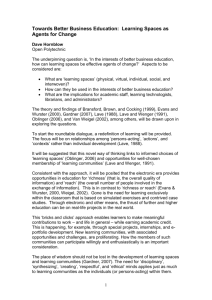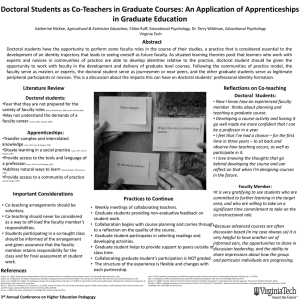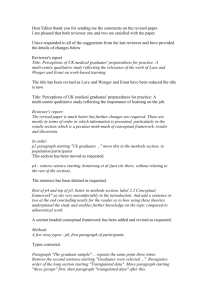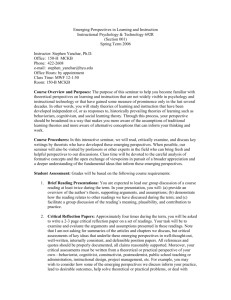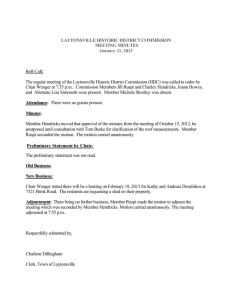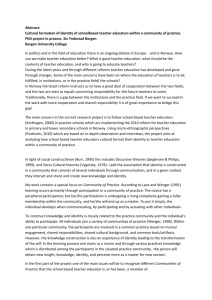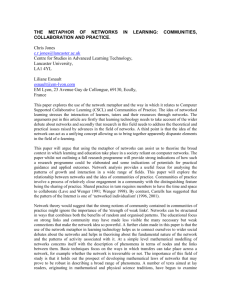12 What is a Community of Practice and How Can
advertisement
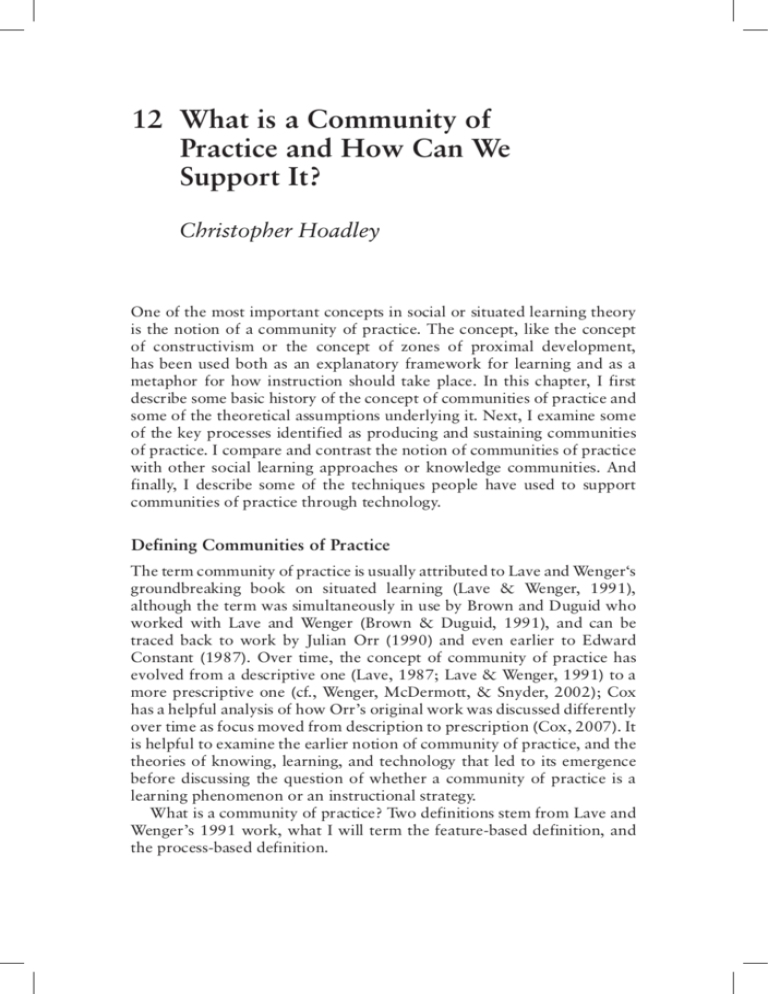
12 What is a Community of Practice and How Can We Support It? Christopher Hoadley One of the most important concepts in social or situated learning theory is the notion of a community of practice. The concept, like the concept of constructivism or the concept of zones of proximal development, has been used both as an explanatory framework for learning and as a metaphor for how instruction should take place. In this chapter, I first describe some basic history of the concept of communities of practice and some of the theoretical assumptions underlying it. Next, I examine some of the key processes identified as producing and sustaining communities of practice. I compare and contrast the notion of communities of practice with other social learning approaches or knowledge communities. And finally, I describe some of the techniques people have used to support communities of practice through technology. Defining Communities of Practice The term community of practice is usually attributed to Lave and Wenger‘s groundbreaking book on situated learning (Lave & Wenger, 1991), although the term was simultaneously in use by Brown and Duguid who worked with Lave and Wenger (Brown & Duguid, 1991), and can be traced back to work by Julian Orr (1990) and even earlier to Edward Constant (1987). Over time, the concept of community of practice has evolved from a descriptive one (Lave, 1987; Lave & Wenger, 1991) to a more prescriptive one (cf., Wenger, McDermott, & Snyder, 2002); Cox has a helpful analysis of how Orr’s original work was discussed differently over time as focus moved from description to prescription (Cox, 2007). It is helpful to examine the earlier notion of community of practice, and the theories of knowing, learning, and technology that led to its emergence before discussing the question of whether a community of practice is a learning phenomenon or an instructional strategy. What is a community of practice? Two definitions stem from Lave and Wenger’s 1991 work, what I will term the feature-based definition, and the process-based definition. 288 Christopher Hoadley Feature-Based Definition of Community of Practice The first, feature-based definition comes from the words themselves: a community that shares practices. Anthropological perspectives on technology adoption, knowledge management, and learning had come to view that learning was not a property of individuals and the representations in their heads (the cognitive view), but rather a more relational property of individuals in context and in interaction with one another (the situated view). Orr’s work on Xerox photocopy repairmen described a situation in which knowledge was not handed off, but co-constructed, by technicians who could not rely on manuals, standard operating procedures, or what they had been taught formally. Instead, through the construction and sharing of stories, and through joint problem solving, the repairmen were able to come to understand far more about how to repair copiers than the manuals could provide. This example of innovation and learning contradicted a more instructivist characterization in which experts or researchers would generate knowledge, which would then be transmitted to learners. Rather, the copy repair provided an example of learning which was situated in the context of problem solving; which was largely related to tacit knowledge, that could only be made explicit through social processes in the context of an actual problem; and which was indicative of the difficulty of attributing “knowing” to a single individual in the setting. While studying practices, their meanings and contexts, and their persistence, prevalence, and scope is a core part of anthropology, Orr’s work, and later Lave and Wenger’s, presents a key insight; namely, that knowledge, and therefore learning, were embedded in cultural practices. This insight was tied to earlier work in science and technology studies. Previously, Constant (1987) had argued that the combination of “practice” and “community” was the best grain size at which to describe knowledge. Constant considered the question of knowledge management and innovation, and highlighted how both organizational perspectives on knowledge and systems perspectives on knowledge were limiting when considering technological innovation. Rather, he highlighted how knowledge was embedded in practices, and how communities of practitioners who shared practices might be the correct unit of analysis to examine knowledge. Coming from a history of science/knowledge management perspective, the issue of individual knowledge in the head was never central for Constant; instead the question was at what social granularity would studying knowledge (especially innovative knowledge) make sense. One of the obvious choices in Constant’s purview would have included the firm or organization as holder of knowledge; this would connect to the idea of organizational knowledge management in companies. Another, which Constant explicitly considered, was the socio-technical system. Actor-network theory and activity theory are both examples of theories at the grain size of system, where the scope of What is a Community of Practice and How Can We Support It? 289 consideration is the scope of connected people and tools (e.g., a mainframe computer and all its users); of course, the difficulty is deciding what constitutes sufficient connection and therefore where the boundaries of a system lie. A third grain size which is not explicitly discussed by Constant but which also would have been reasonable is the grain size of a culture; however, cultural knowledge tends to describe commonalities across large groups of people, indeed some define the boundaries of culture by shared knowledge. The grain size of culture is not the most useful for studying noteworthy knowledge which is not evenly distributed, i.e., not useful for studying innovative or high-leverage knowledge. As Brown and Duguid (1991) put it, some knowledge is “sticky” while other knowledge is “leaky”. That is to say, some knowledge tends to reside within certain groups of people despite organizational or personal pressure to distribute it better: for example, the highly technical knowledge of an experienced computer user, which is quite difficult to distribute widely even though it may be of high value to others; or best practices in public health, which are easy in many cases to convey to people (“wash your hands,” or “don’t smoke”) but which might “bounce off ” the target population—this type of knowledge could be called “sticky” knowledge because it is difficult to spread around. Leaky knowledge is the opposite; an example might be an innovation that a company would like to keep as a trade secret, but which spreads like wildfire despite all efforts to the contrary. Brown and Duguid point out that knowledge can be both sticky and leaky simultaneously, spreading easily in some ways while not in others. Constant’s conclusion in reaction to this situation, taken up by Brown and Duguid, is that the natural “range” or spread of knowledge can be described by looking at communities of people who share practices. The practice is important because it identifies knowledge with something people “do” as part of their culture, profession, or avocations. (As any teacher will attest, knowing without doing seems nearly impossible; whatever learning residue exists rarely sticks.) And, as another key insight, Constant says a practice is not enough to specify where knowledge lives, because disconnected groups may share a practice or even a set of practices, but if they are not in contact (harkening back to the idea of a community as a group of people in communion with each other), the meanings of those practices will not be the same. Simply put, knowledge equals practice in authentic contexts by communities. Various theorists have taken stronger and weaker stances on whether knowledge (or its analog) can actually exist in individuals at all, with Lave and Wenger taking the most strident view, stating that the community of practice is “an intrinsic condition for the existence of knowledge”; clearly, this idea of knowledge-as-situated is very different from the school-oriented notion of knowledge-in-the-head. This connects with one of the central problems of the individualist perspective on learning, the transfer problem. On an individual level, 290 Christopher Hoadley learners may appear to know something (for instance, a skill for solving a math problem), but then fail to apply that knowledge in a context different from the one in which they learned the skill. What appears to be a puzzling defect when examined at an individual level becomes more sensible when looked at as a systemic property of a group of people who all share certain practices. Thus, learning mathematics becomes less a process of inscribing certain facts in the brain, and more one of becoming a person who practices mathematics. Certainly, we can see how this makes sense in specialized professions; a professional mathematician in graduate school learns how to do mathematical research “in communion with” other mathematicians. But it can also be true for young students learning arithmetic. Barab and Duffy (1998, see also Chapter 2), following Senge, described this as “practice fields”—practice in the dual sense of practicing piano, as well as in the sense of a sociocultural practice—in which learners have a practice that is authentically shared by people at a similar stage of learning, even if it is not professional-grade practice. Are minorleague baseball teams “authentic” baseball? What about little league? The idea of practice fields gives us a way to think about these examples— they represent communities that share practices, and in each case there is a possibility of identifying with that community and its behaviors, and becoming more central to its practices. The major league rookie, and the new entrant to little league, both share the opportunity to participate legitimately in the baseball practices of their respective communities, and to gradually identify more and more with those practices. Thus, we see that the feature-based definition of a community of practice entails some fairly important ideas for educators. To sum up, the anthropological view of knowledge and situated learning identifies not knowledge structures in the head (as with cognitive constructivism), nor behaviors conditioned by an environment (as with behaviorism), but rather as a property lying somewhere between individuals and cultures, involving practices in context. Lave and Wenger’s description of naturally occurring communities of practice, for instance the apprenticeship of tailors, highlights the importance of learning being situated in authentic practice contexts or practice fields. Educators, then, must either help embed learners in supportive authentic contexts, or create quasi-authentic contexts in which they can “do” the knowledge that is desired; mere regurgitation is not enough. Defining Communities of Practice as a Process The second, process-based definition of community of practice, put forth by Lave and Wenger as a description of the process of knowledge generation, application, and reproduction, is that communities of practice are groups in which a constant process of legitimate peripheral participation takes place. Through legitimate peripheral participation, What is a Community of Practice and How Can We Support It? 291 learners enter a community and gradually take up its practices. Initially, people may participate in tangential ways, but over time, they take up more and more of the identity of group membership and centrality, and more and more of the central practices of the group. While later work on legitimate peripheral participation has often focused on participation in the form of discursive practice (e.g., Kilner, 2004; Senge, 1990), this practice can take any form (consider a community of practice of traditional dance, for instance). Lave and Wenger identify the reproduction (and evolution) of knowledge through the process of joining and identifying with communities as the central and defining phenomenon within a community of practice. Again, this notion of learning has profound educational implications. For one, in the community of practice view, learners must have access to experts, and must either perceive themselves to be members or aspire to membership in a community in which expert practices are central; contrast this with the ways students are segmented into grades or levels within schools. Secondly, there is a bootstrapping problem; if learners are to enculturate themselves by joining a community of practice, it must already exist, with some sort of common history and an identity (Barab & Duffy, 1998). Third, there must be space in an educational system for legitimate peripheral participation. Often, schools emphasize uniformity in behaviors that may delegitimize the participation of those who are more peripheral. To take a concrete example, if a student wishes to “lurk” in class more before eventually identifying enough to speak, they need to have a space in which it is legitimate to be on the periphery of classroom discussion. Similarly, in a lecture format a student may have no opportunity to participate in any practice related to the knowledge at hand. A strict division of labor between a teacher lecturing and a student completing exercises robs the student of any way of participating more and more like the only expert they have access to, their teacher. This process seems unlikely to allow a student to develop any sort of identification with the authentic practices of the classroom, much less the world outside the classroom. Communities of Practice vs. Other Knowledge Communities As mentioned earlier, the idea of a community of practice has broadened considerably since it was popularized by Lave and Wenger and Brown and Duguid. While Constant initially used it as a descriptor of a type of knowledge, and Lave and Wenger used it as an explanatory theory describing the naturally occurring processes underlying all knowledge and learning, writings since then have often altered the concept in two ways. The first shift has been from communities of practice as an endemic phenomenon that occurs naturally to one that can be explicitly created and fostered, whether by a teacher, a chief information officer, or a 292 Christopher Hoadley community organizer. The second change, linked with the first, is away from the anthropological and social aspects of the community of practice and towards the physical manifestation of communities of practice via external representations and explicit rules, i.e., technology platforms which instantiate a particular way of supporting or fostering community of practice. This is analogous to the idea of constructivism as a learning theory gradually being transformed into constructivism as a description of a family of teaching strategies (as explored elsewhere in this volume). It is entirely reasonable to want to understand pedagogical implications of a good learning theory, but it is important that we are careful to distinguish between theory and design. To advance social theories of learning, we need to remember some of the different assumptions and implications of different explanatory theories, and try to remember the role of designer/ educators in implementing educational strategies when they use those theories to create learning environments. For example, the terms knowledge-building community and community of practice are sometimes used interchangeably; or occasionally with one as a special case of the other (e.g., Hoadley & Kilner, 2005). In this volume, knowledge-building communities are discussed as a framework for understanding social learning environments. The two concepts appear similar, but we can highlight several key differences. Most notably, a knowledge-building community is intentional, that is, the goal of the community (or of the organizers of the community) is explicitly on learning and building knowledge, whereas Orr’s copier repairmen had a different goal, which was to do their jobs and to be comfortable within their professional identity. Learning was an incidental, instrumental aspect of that process. Contrast this with Scardamalia and Bereiter’s emphasis on the transformative power of a learner developing and setting her own agenda for knowledge construction (Scardamalia & Bereiter, 1991); they argue that agency becomes a key driver of the community learning process, where a copier repairman might have limited agency in setting the agenda of his or her own day, much less the agenda of the community of other repairmen. A second difference between the two is the source and nature of authenticity. While it is presumed in both cases that a learner who is successful will be increasingly identified with the community’s practices as something they do and that defines their own lives, a knowledge-building community may be investigating questions that derive from an individual’s curiosity, or from a teacher’s initial agenda setting. A community of practice that occurs naturally will not typically have a learning goal; these will emerge depending on the evolution of the community’s function and role within society. Practice fields may allow more preparatory types of learning to take place than those in professional practice, but ultimately little league has to be fulfilling enough on its own to survive, even if it might lead to the major leagues. Knowledge-building communities may not be limited in this way. Hoadley and Kilner (2005) What is a Community of Practice and How Can We Support It? 293 argue that once a knowledge-building community is up and running, it does constitute a community of practice, one in which the core practice is an inquiry one. Knowledge-building communities are just one example of many different kinds of communities that may be compared and contrasted with communities of practice. Unfortunately, terminologies are not always consistent; while “communities of learners” may have a more technical definition, the phrase may also be used more generically. Other terms which may have varying definitions include “knowledge networks”, “communities of interest”, and even “communities of practice” itself. However, despite the lack of common terms, it’s helpful to examine some of the dimensions in which different configurations of groups of people and learning activities can be classified. Andriessen (2005) undertook a review of the literature and attempted to create a taxonomy of types of “knowledge communities” (his attempt to create an umbrella term to encompass all communities that support or generate knowledge) based on both published accounts and extraction of key features of archetypical knowledge communities. Several key distinguishing features of different types of knowledge communities were identified, including whether or not they have common purpose, whether they have commitment to a shared deliverable (“contract value”), whether there is a defined membership, the formality or informality of the group (for instance, whether there are formal rules, meeting schedules, a coordinator, etc.), composition (heterogeneous or homogeneous), degree of interaction or reciprocity, whether the community has a strong identity, whether it crosses or lies within formal organizations, whether it is geographically distributed or not, and to what degree the interaction within the group is technologically mediated. After assembling this list of features, Andriessen did, in essence, a factor analysis, and then clustered archetypical communities that had combinations of these features. Andriessen found two correlated sets of characteristics that he used to produce two key dimensions of variability among knowledge communities. The first dimension he termed “connectivity”, and it boiled down to the degree of social connectedness of the members, primarily relying on identity and degree of interaction. We might treat it as the “are these people all part of a social group?” test. The second dimension Andriessen identified was “institutionalization,” which comprised contract value (deliverables), shared purpose, defined membership, composition, and formalization. One might think of it as “are these people part of a formal, goal-oriented team?” (Interestingly, geography, size, whether a group was intra- or inter-organizational, and whether or not a group was technologically mediated were not found to correlate with how communities were classified.) After plotting the communities in this two-dimensional space, Andriessen identified five clusters. With low connectivity and institutionalization, he found interest groups, groups 294 Christopher Hoadley of people with some shared interest but no real cohesion. He termed groups with moderate connectivity but low institutionalization “informal networks” and included in this group what Wenger termed “communities of interest” and what Brown had termed “networks of professionals”. In the category of high connectivity but low institutionalization, which Andriessen calls “informal communities”, he includes most definitions of community of practice, including the classic Lave and Wenger definition. In the case of high institutionalization, Andriessen termed high connectivity groups “strategic communities,” and in this case he included highly structured, purposefully created communities of practice such as some corporate project teams (we might envision a school-based knowledge-building community in this category). Finally, in the case of low connectivity and high institutionalization, Andriessen finds a gap in the knowledge communities literature, but posits including “communities” such as participants in a formal Delphi process, in which cycles of surveys and summaries are used to construct a common consensus among experts without significant person-to-person contact. One can use Andriessen’s dimensions to consider educational knowledge communities as well. Where a naturally occurring community of practice might be low institutionalization and high connectivity, an ongoing study group might be high connectivity and low-to-moderate institutionalization, a university graduate student support group mailing list might be moderate-to-high institutionalization but low connectivity, and so on. Perhaps because Andriessen’s review was grounded more in the information technology and knowledge management literature, a dimension that appears to be absent is the degree to which learning is a goal vs. other professional outcomes. Clearly one of the biggest differences between knowledge-building communities and communities of practice is the degree to which the core practice or value of the community is a learning practice as opposed to some other authentic professional or livelihoodrelated practice, and we might imagine expanding Andriessen’s taxonomy into three dimensions. This would allow us to consider what might be the “educational” version of each of his categories: what, for instance, would be the “educational” equivalent of a loose-knit community of interest? In any case, the distinctions between types of communities are relevant in instructional design, since issues like the degree of connectivity expected between learners or the degree of formality and institutionalization may change the character of the community, and thus may profoundly impact the type of learning processes we might expect to take place in that community. If a group of university students in a large lecture participate in a discussion board in their course management system, will they truly be a high connectivity community? Though the teacher might label the group a “community of practice,” the students’ identification with the group, their ability to share a common practice with their peers, and so What is a Community of Practice and How Can We Support It? 295 on may not reach the threshold to allow the process of enculturation and legitimate peripheral participation to take place. Technology and Communities of Practice The ties between technology and communities of practice run deep; as previously described, Orr, Constant, Brown and Duguid, and Lave and Wenger all had ties to knowledge management in the 1990s which was a de facto technology endeavor. One of the key drivers of technology adoption in the corporate space was the sense that information was a strategic asset for companies, and that its value was increased not only through the calculating aspects of computation, or even the transmission and copying aspects of computer-based information, but more importantly through technology‘s support of information routing, filtering, and transformation (e.g., Taylor, 1986). More recently, networked technology has allowed communication to become increasingly time and place independent, with ever richer communication channels, to the point where Andriessen found that distributed vs. face-to-face was not a primary issue in his taxonomy of the literature on knowledge communities (Andriessen, 2005). Wenger’s more recent work, with White and Smith, has emphasized the role technology can play in providing a platform for a community of practice (Wenger, White, & Smith, 2010). Although one can conceive of technology supporting either the community, or the shared practice, or both, typically scholars have investigated technology’s role in supporting the community (i.e., communication) rather than the practice itself. For example, an online discussion board might be used to support hobbyist quilters worldwide. In that case the technology is supporting the communication among the quilters, but presumably doesn’t support the quilting itself. On the other hand, if the quilters used software that helped them lay out a quilt design in advance, that would be an example of technology supporting the practice. One can easily imagine that such software would also allow quilters in different locations to collaborate on designing a quilt; this would be an example of the technology supporting both the communication and the practice. To be clear, we can conceive of any artifact or cultural invention to be a technology (Hutchins, 1995), but the technologies which have been the primary focus of education and community of practice researchers are information and communication technologies, i.e. computers and their ilk. What are some of the ways in which technology can support a community of practice? Hoadley and Kilner (2005), after Hoadley and Kim (2003), identify three areas of technology affordance relevant to communities of practice including content, process, and context (CPC). The content affordance refers to the representational abilities of technology, including the ability to store and manipulate information in a variety of formats (e.g., multimedia affordances, search, data processing, 296 Christopher Hoadley etc.), to transmit representations across distance or allow time-shifting (for instance, in asynchronous collaboration), and the ability to support human representational capacity (for example, allowing a writer to quickly and easily edit text in a word processor, as opposed to using a typewriter or writing longhand). The process affordance refers to technology’s ability to scaffold a particular task, activity, or sequence of actions; for example, an enterprise technology in a company might constrain and implement a particular business process by helping route documents to allow an invoice to be paid, or a learning tool might guide a student through the steps of an inquiry cycle in science class. The third affordance, context, refers to the ability of technology to shift the social context of the user. For instance, an online forum might allow people with similar practices to form a community at a distance, a discussion tool might support more gender equitable discussion by allowing anonymity, or a social networking tool may allow someone to communicate with a much broader audience than face-to-face communication. These three affordances are ways in which technology tools may be deployed or designed to add value or improve learning generally, and a community of practice specifically. Several books on communities of practice focus not on the naturally occurring variety described by Lave and Wenger, but rather on the community of practice as a goal for both educators, managers, or even scientists (e.g., Dixon, Allen, Burgess, Kilner, & Schweitzer, 2005; Kimble, Hildreth, & Bourdon, 2008; Olson, Zimmerman, & Bos, 2008; SaintOnge & Wallace, 2003; Wenger, 1998; Wenger et al., 2002). We must be careful to distinguish between a community of practice as a phenomenon (naturally occurring or otherwise), versus an intended or designed learning environment, versus the tools used to support a community of practice that interacts primarily online. For educational designers, the key question is how technology might support either the formation or the continuation of a community of practice in which desired learning takes place. Recognizing that one can neither force a community nor a set of practices, what are some techniques in which technology is used to foster a learning-oriented community of practice? Below, I describe four such techniques, including linking others with similar practices; providing access to shared repositories; supporting conversation within a community; and providing awareness of the context of information resources. These four strategies follow four of the target areas in the C4P model of communities of practice identified in Hoadley and Kilner (2005). This model, created by Kilner and colleagues who run the CompanyCommand online community of practice for soldiers (Kilner, 2004), envisions the structure of an online community of practices as consisting of four factors—content, conversation, connections, and information context—supporting a common purpose. As noted previously, the community of practice may or may not be particularly task-oriented, and indeed the canonical models identified by Lave and Wenger are more What is a Community of Practice and How Can We Support It? 297 oriented towards communities whose only shared purpose is to conduct the practices that help define that community (e.g., a tailors’ community of practice has a shared purpose of tailoring, a community of practice of doctors has a shared purpose of practicing medicine, and so on). While many techniques are possible to support communities of practice with technology, we list these four strategies both because they cover the four c’s in the C4P model, and because they are illustrative of common ways people support communities of practice with technologies. The first technique for using technology to support a community of practice is linking people with others who have similar practices. As discussed above, sharing a practice is not enough to form a community of practice—the practitioners have to have what Andriessen termed connectivity. Social networking tools ranging from the more open, like Facebook (anyone can join), to the more closed, like the US Military’s CompanyCommand (restricted to US military company commanders), can help what Kilner et al. termed “connections”. This may include locating other people who share similar practices, which is especially important if novice or peripheral participants don’t readily know who are the more central members of the existing community. For example, a Facebook group might be set up for automobile restoration hobbyists and professionals. People might gradually sign up for the group, but then develop individual relationships with others in the community, perhaps “friending” them, and using features like the NewsFeed to deepen the relationship through greater awareness of each others’ lives, and so on. Other platforms might have features like corporate directories or profiles that allow like-minded individuals to find one another, and so on. A second technique for using technology to support communities of practice is to provide some sort of shared repository of information resources. While a simplistic view of knowledge might think that this repository is the knowledge of the community, the community of practice view sees such repositories as simply information that is used by the community in its practices (where the knowledge truly resides). For example, corporate knowledge management systems might contain an information repository for sales contacts. Members of the community of practice that conduct sales would presumably use and maintain this repository as part of their practices in selling products to customers, and if the repository were designed to allow it, might help more peripheral members of the sales team to have access to some of the practices of more expert salespeople. Or, a community of practice of university students in a writing course might use a wiki as a shared repository for references and drafts of papers, with access to each other’s work (supporting, again, legitimate peripheral participation, perhaps in the form of reading each other’s work in preparation for class discussion). In the C4P model, this would be a way of supporting content. 298 Christopher Hoadley A third technique is directly supporting communication by providing tools for discussing with others. This is, perhaps, the most common use for technology in communities of practice: supporting, as C4P terms it, conversation. Examples could range from a bulletin board used globally by members of a support group for a rare disease, to commenting tools for blog posts in a password-protected blog for members of a professional association, to an online videoconferencing tool used for informal consultation among doctors on difficult medical cases. Obviously, people can have conversations relevant to a community of practice in person or via written form on paper, but if the people are geographically distributed or need structure to discuss effectively, Internet-based technologies readily serve to allow new possibilities for conversation. Conversation need not look like the traditional threaded discussion tools. For instance, a more exotic form of technology supporting conversation might be using a virtual world like Second Life to generate a context in which people can communicate—a participant in a virtual conference might use their avatar’s body language like sitting in rows in front of a virtual podium, or moving through a more cocktail-party-like arrangement of avatars to help structure textual chat. A fourth technique used to support communities of practice with technology is providing awareness in a community of the information context of various resources. For example, an online bookstore might provide automated recommendations that would help a member of a community uncover what sorts of books are typically read by the same people, or the history (editing log) in a tool like Wikipedia might provide information about how an encyclopedia entry came into being, and perhaps even the goals or attitudes of the various editors of that page over time. In the C4P framework, this is helping establish the information context for shared information resources. These four techniques correspond to one for each of Kilner et al.’s C4P framework, but they are by no means an exhaustive list of ways technology can use content, process, and context affordances to change or support communities of practice. Rather, they are a few of the more commonly applied techniques in each area of C4P. For instructional designers attempting to create or select a technology platform for a community of practice, there is no one correct or optimal technology which will allow a community of practice to thrive. “Community of practice” is not the name of a particular software genre. Instead, any tool or set of tools which support a group of people working in a community through shared practices can be the platform for a community of practice, whether it is a wiki, a blog, a virtual world, a course management system, or simply telephones and email. Again, the C4P model, and the CPC framework can help identify aspects of the community to be supported, and affordances of technology that can address these aspects. What is a Community of Practice and How Can We Support It? 299 Summary A community of practice is an important theoretical construct that underlies a particular model of learning, namely, learning in which people, through a process of legitimate peripheral participation, take up membership in and identity with a community which serves as the home of these shared practices. While knowledge communities can take many forms, (communities of interest, knowledge-building communities, Delphi groups, etc.) communities of practice typically have a degree of informality (low to moderate institutionalization, making them a community and not an organization), and high connectivity (rather tight social relationships between members of the community, and a relatively high degree of identification with the group). Communities of practice rely on situated theories of knowledge, i.e., the idea that knowledge is a property enacted by groups of people over time in shared practices, rather than the idea that knowledge is a cognitive residue in the head of an individual learner. Educators and instructional designers may capitalize on the communities of practice model by trying to instantiate or support communities in which desired practices reside, and allowing learners to engage through the process of legitimate peripheral participation. While no manager, teacher, or designer can create a community of practice by fiat, such communities can be supported or fostered through a variety of means, many of which involve providing technologies that support the community. Technology has affordances that allow it to represent content, scaffold processes, and shift the user’s social context. These affordances can be applied to support one or more of the key aspects of the functioning of a community of practice: connections, conversations, content, and information context. References Andriessen, J. H. E. (2005). Archetypes of knowledge communities. In P. van den Besselaar, G. De Michelis, J. Preece & C. Simone (Eds.), Communities and technologies (pp. 191–213). Milan: Springer. Barab, S., & Duffy, T. (1998). From practice fields to communities of practice (pp. 31). Bloomington, IN: Center for Research on Learning and Technology. CRLT Technical Report 1–98, http://crlt.indiana.edu/publications/duffy_publ3.pdf [accessed July 10, 2011]. Brown, J. S., & Duguid, P. (1991). Organizational learning and communitiesof-practice: Toward a unified view of working, learning, and innovation. Organization Science, 2(1), 40–57. Constant, E. W., II (1987). The social locus of technological practice: Community, system, or organization? In W. E. Bijker, T. P. Hughes & T. J. Pinch (Eds.), The social construction of technological systems (pp. 223–242). Cambridge MA: MIT Press. 300 Christopher Hoadley Cox, A. (2007). Reproducing knowledge: Xerox and the story of knowledge management. Knowledge Management Research and Practice, 5(1), 3–12. Dixon, N. M., Allen, N., Burgess, T., Kilner, P., & Schweitzer, S. (2005). CompanyCommand: Unleashing the power of the army profession. West Point, NY: Center for the Advancement of Leader Development & Organizational Learning. Hoadley, C., & Kilner, P. G. (2005). Using technology to transform communities of practice into knowledge-building communities. SIGGROUP Bulletin, 25(1), 31–40. Hoadley, C., & Kim, D. E. (2003). Learning, Design, and Technology: Creation of a design studio for educational innovation. In A. Palma dos Reis & P. Isaís (Eds.), Proceedings of the IADIS International Conference e-Society 2003 (pp. 510–519). Lisbon, Portugal: International Association for the Development of the Information Society, IADIS. Hutchins, E. (1995). Cognition in the wild. Cambridge, MA: MIT Press. Kilner, P. G. (2004). The Con-4P Model of Learning Design for Professional Communities. In J. Nall & R. Robson (Eds.), Proceedings of E-Learn 2004 (pp. 1307–1311). Norfolk, VA: Association for the Advancement of Computing in Education. Kimble, C., Hildreth, P. M., & Bourdon, I. (2008). Communities of practice: Creating learning environments for educators. Charlotte, NC: Information Age Pub. Lave, J. (1987). Cognition in practice. New York, NY: Cambridge University Press. Lave, J., & Wenger, E. (1991). Situated learning: Legitimate peripheral participation. New York: Cambridge University Press. Olson, G. M., Zimmerman, A., & Bos, N. (2008). Scientific collaboration on the Internet. Cambridge, MA: MIT Press. Orr, J. E. (1990). Sharing knowledge, celebrating identity: Community memory in a service culture. In D. Middleton & D. Edwards (Eds.), Collective remembering (pp. 169–189). Newbury Park, CA: Sage Publications. Saint-Onge, H., & Wallace, D. (2003). Leveraging communities of practice for strategic advantage. Boston: Butterworth-Heinemann. Scardamalia, M., & Bereiter, C. (1991). Higher levels of agency for children in knowledge building: a challenge for the design of new knowledge media. Journal of the Learning Sciences, 1(1), 37–68. Senge, P. M. (1990). The fifth discipline : the art and practice of the learning organization (1st edn.). New York: Doubleday/Currency. Taylor, R. S. (1986). The value-added model. In R. S. Taylor (Ed.), Value-added processes in information systems (pp. 48–70). Norwood, NJ: Ablex. Wenger, E. (1998). Communities of practice: Learning, meaning, and identity. Cambridge, UK: Cambridge University Press. Wenger, E., McDermott, R. A., & Snyder, W. (2002). Cultivating communities of practice: A guide to managing knowledge. Boston, MA: Harvard Business School Press. Wenger, E., White, N., & Smith, J. D. (2010). Digital habitats: Stewarding technology for communities. Portland, OR: CPSquare.
